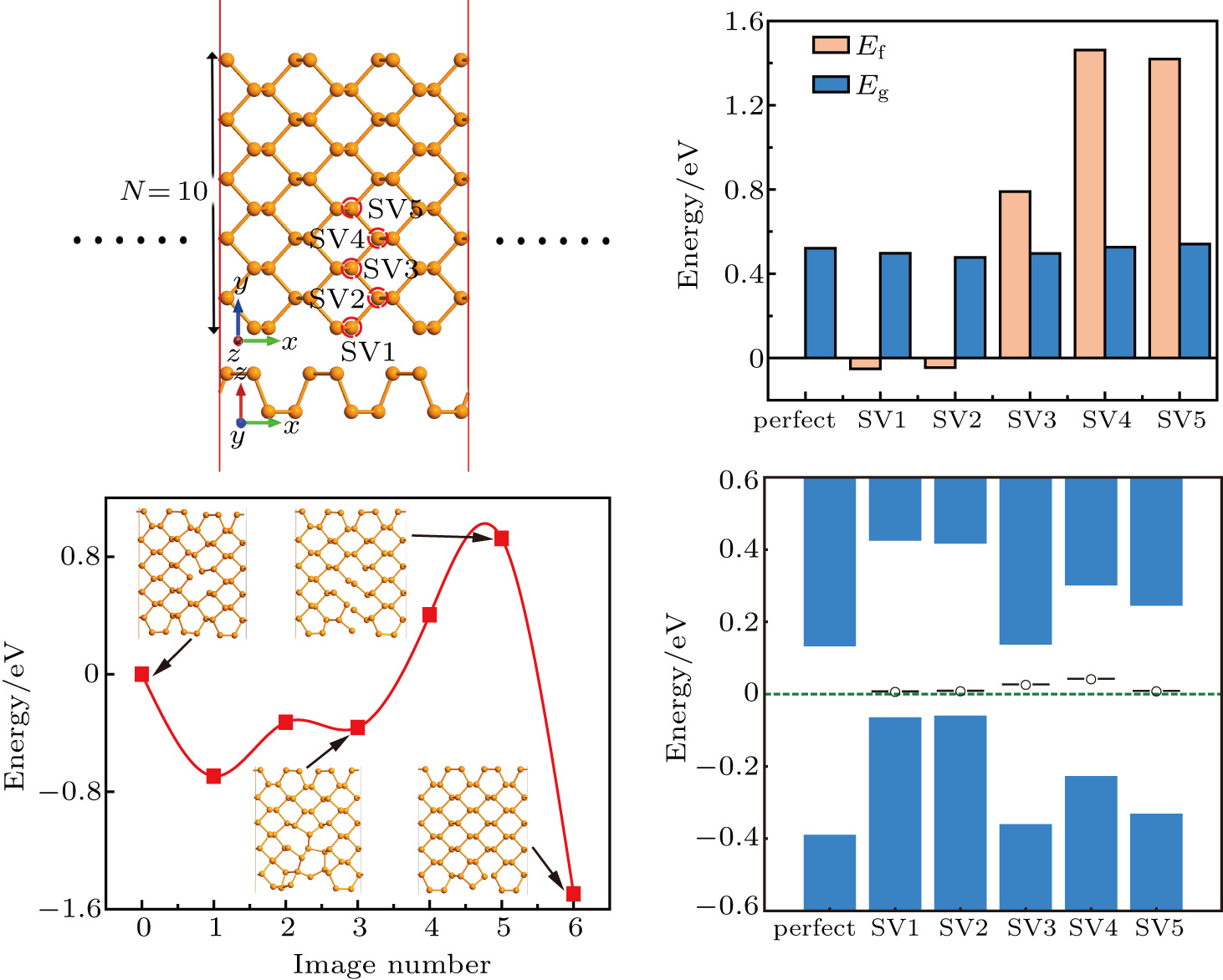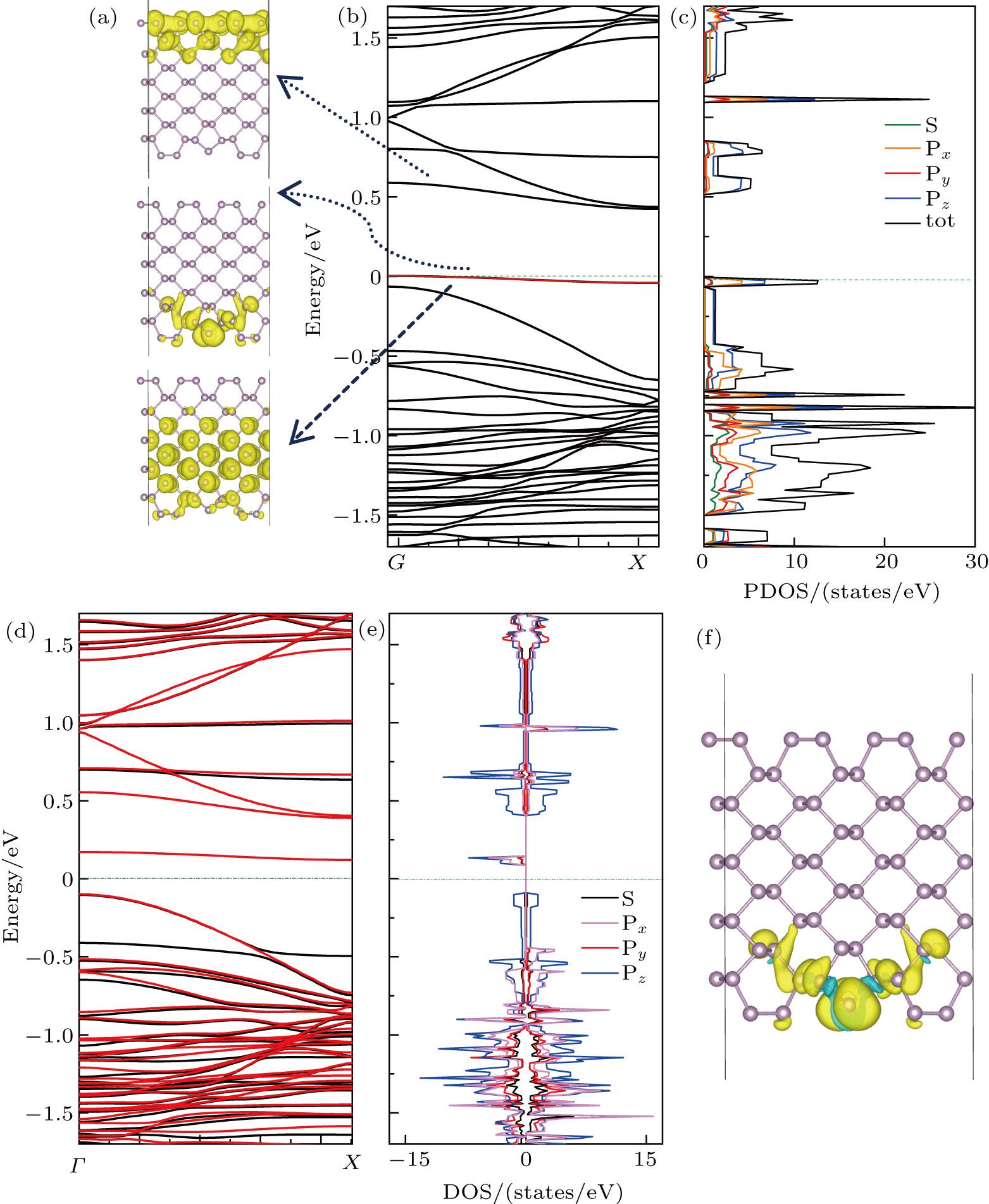† Corresponding author. E-mail:
Project supported by the National Natural Science Foundation of China (Grant Nos. 11574080 and 91833302).
We investigate the electronic and transport properties of one-dimensional armchair phosphorene nanoribbons (APNRs) containing atomic vacancies with different distributions and concentrations using ab initio density functional calculations. It is found that the atomic vacancies are easier to form and detain at the edge region rather than a random distribution through analyzing formation energy and diffusion barrier. The highly local defect states are generated at the vicinity of the Fermi level, and emerge a deep-to-shallow transformation as the width increases after introducing vacancies in APNRs. Moreover, the electrical transport of APNRs with vacancies is enhanced compared to that of the perfect counterparts. Our results provide a theoretical guidance for the further research and applications of PNRs through defect engineering.
Black phosphorene (BP), as an emerging two-dimensional (2D) material, can be fabricated from bulk phosphorus by mechanical or liquid phase stripping method owing to its weak van der Waals interlayer interaction.[1] Due to its unique electrical properties, such as high carrier mobility of 1000 cm2⋅V−1⋅s−1 and switching ratio of 104,[2,3] BP will become a candidate for a channel semiconductor material that overcomes the shortcomings of graphene with zero bandgap and transition metal dichalcogenides (TMDs) with low mobility.[4,5] Similar to the related 2D materials, the electrical properties of BP can be modulated by means of strain,[6] electric field,[7] doping,[8] and construction of heterojunctions.[9,10] In particular, its strongly anisotropic features have great potential applications in optoelectronic and semiconductor devices.[11,12]
The electronic and transmission characteristics of BP can be greatly influenced by the edge state when it reduces from a 2D nanosheet to a 1D nanoribbon.[13–17] Very recently, high quantity phosphorene nanoribbons (PNRs) have been fabricated by the ionic scissor method.[18] In general, PNRs can be divided into two kinds of modes, i.e., zigzag-PNRs (ZPNRs) and armchair-PNRs (APNRs) in the light of edge chiral. Physically, metallic ZPNR exhibits negative differential resistance effect (NDR) because the nonlocal resonance edge states cross the Fermi level.[19–21] However, for the case of APNR, it remains semiconductor behavior.[22–26]
Noticeably, introducing a new state in the gap is an effective method to alter the physical and chemical properties by means of defect engineering.[27–33] For the case of BP, it has poor chemically stable and abundant defects.[34] Also, BP has more intrinsic defects than graphene and silence due to lower structure symmetry.[35,36] Thus, the introduction of impurity levels is the main reason that the BP is the p-type semiconductor.[37] For the ZPNR, the NDR effect will be reduced or even eliminated by vacancies,[38] while for the APNR with point defects, it exhibits a lower quantum conductance owing to Anderson localization.[39,40] However, in APNR, the mechanism of defect formation and related evolution remains unclear, and the understanding of transport properties is still insufficient.
In this work, we explore the defect engineering on the structural stability, electronic and transport properties of APNRs based on the ab initio calculations. All possible vacancy distributions and different concentrations are taken into account in our case. It is found that the vacancies can be favorable for detaining at the edges instead of unordered. When a single vacancy is formed at the edge of APNR, the band edge will be greatly offset, and the emerging quasiflat defect level (DL) is pinned at the Fermi level near the valence band maximum (VBM). Importantly, the shorter the separation between DL and VBM is, the wider the transmission platform becomes. Our results show that the electric properties of APNRs can be modulated by the defect concentration and nanoribbon width, providing a theoretical guidance of structural design of APNRs.
The computations of geometric optimization and electronic properties of PNRs are implemented in the Vienna ab initio simulation package (VASP) code based on the density functional theory (DFT). Exchange and correlation potentials are described by the generalized gradient approximation (GGA) with the Perdew–Burk–Ernzerhof (PBE) function.[37,41] Hellmann–Feynman force is requested to be smaller than 0.05 eV/Å for each atom after full relaxation. The plane wave cutoff energy is set at 400 eV and electronic minimization is performed with a tolerance of 10−5 eV. A 7 × 1 × 1 Monkhorst–Pack k-points grid is adopted for the Brillouin zone. Defect migration barrier and electrical transport properties are calculated by enforced DFT combined with the non-equilibrium Green function (NEGF) in the software Atomistic ToolKit (ATK).[42,43] Notably, the migration barrier is simulated by the nudged elastic band (NEB) method that provides a way for finding the minimum energy path between initial and final structures. The cutoff energy with 120 Ry and 1 × 1 × 150 k-points are employed for transport calculations. Numerical integration and Poisson equation are solved using the fast Fourier expansion method. In the light of the Landauer–Büttiker transport formula, the current can be expressed as[44]

The configuration of an APNR is shown in Fig.
First of all, five non-equivalent single vacancies SV1–SV5, about 1.6% defect concentration, are introduced from the edge to the middle region. In order to estimate the favorite vacancy location, we calculate the formation energy in terms of the relationship

It should be noted that the vacancies are not stationary in APNRs. Therefore, the possible diffusion should be taken into account. We use the NEB approximation to calculate the activation energy of phosphorus vacancy migration pathway between SV5 and SV1. As shown in Fig.
In order to obtain the deep understanding of vacancy effect, we calculate the partial differential charge, band structure and projected density of state (PDOS) in the case of SV1 with/without spin polarization, as shown in Figs.
To investigate the electrical transport properties, we built a two-probe device as shown in Fig.
Obviously, the perfect APNRs exhibit integer quantum transmission characteristics that the spectra consist of a series of steps in the range of high or low energy. However, when the vacancy defect appears and draws near the center region, the transmission coefficient of the low energy part declines and the integer quantum transmission disappears. All transmission gaps are approximately 0.5 eV. The DL is local so that it does not correspond to the transmission peak inside the bandgap. This phenomenon also referred as the Anderson localization.[39] Moreover, the I–V curve is also an important characteristic of the electronic device (Fig.
In order to thoroughly analyze the phenomenon of current boost in the defective nanoribbons, we calculate bias voltage dependence of transmission spectrum (Fig.
In general, there are two ways to change the defect concentration in the DFT calculations: one is to expand or shrink the supercell, and the other is to introduce multiple vacancies. For the former, to explore the joint effect of nanoribbon size and defects, we select the SV1-APNRs with various widths possessing the lowest formation energy to study. Figures
 | Fig. 4. (a) Formation energy and bandgap, (b) band edge and DL respect to Fermi level, and (c) net magnetic moment as a function of nanoribbon width. |
Upon the transport behavior, the APNR devices with N = 6 to N = 10 containing SV1 defects are constructed to calculate the transmission spectrum under zero bias (Fig.
Unlike changing the supercell size to adjust defect concentration, we should consider the interaction between vacancies in APNRs with multiple vacancies. Based on the structure of SV1-APNRs with N = 10, we construct a series of APNRs with double vacancies about defect concentration of 3.2% at identical edge (DsV1–4) or different edges (DdV1–5) (Fig.
 | Fig. 6. (a) Structure of multiple vacancies of APNR, (b) formation energy and bandgap, as well as (c) band edges and DL with respect to the Fermi level of APNR with different multiple vacancies. |
| Table 1. The magnetic moment of different defect types in APNRs. . |
In Fig.
In summary, using the density functional theory and non-equilibrium Green’s function, we investigate the electronic and transport properties of one-dimensional defective APNRs. It is revealed that vacancies prefer to trap in the edge region owing to low formation and high diffusion barrier. All single vacancies introduce a local defect state near the VBM with 0.9μB magnetic moment originally from pz orbital, which enhances transport current by 1.2–1.5 times. The structure instability, magnetic moment and bandgap are reduced when the width increases. Notably, the DL takes a deep-to-shallow transformation that can improve the electrical transport performance. Moreover, the number of DL is an important factor for transport, showing a dependence on edge notch and edge reconstruction in the APNRs with multiple vacancies. Therefore, defect engineering is an effective method to improve electronic and transport properties of APNRs and can also be applying for the relevant applications.
| [1] | |
| [2] | |
| [3] | |
| [4] | |
| [5] | |
| [6] | |
| [7] | |
| [8] | |
| [9] | |
| [10] | |
| [11] | |
| [12] | |
| [13] | |
| [14] | |
| [15] | |
| [16] | |
| [17] | |
| [18] | |
| [19] | |
| [20] | |
| [21] | |
| [22] | |
| [23] | |
| [24] | |
| [25] | |
| [26] | |
| [27] | |
| [28] | |
| [29] | |
| [30] | |
| [31] | |
| [32] | |
| [33] | |
| [34] | |
| [35] | |
| [36] | |
| [37] | |
| [38] | |
| [39] | |
| [40] | |
| [41] | |
| [42] | |
| [43] | |
| [44] | |
| [45] | |
| [46] | |
| [47] |






